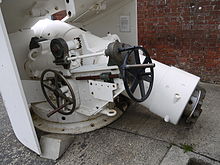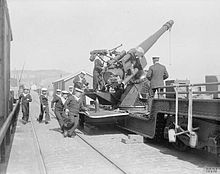QF 6 inch / 40 naval gun
| QF 6 inch / 40 naval gun | |
|---|---|
| General Information | |
| Military designation: | UK: QF 6 inch Mk I, II, III, Japan: Type 41 6-inch (152 mm) / 40-caliber naval gun |
| Manufacturer designation: | QF 6 inch / 40 naval gun |
| Manufacturer country: |
|
| Developer / Manufacturer: | Elswick Ordnance Company Royal Arsenal |
| Development year: | 1891 |
| Start of production: | 1892 |
| Model variants: | Mark I, II, III and Type 41 |
| Weapon Category: | cannon |
| Technical specifications | |
| Overall length: | 6.10 m (240 in) |
| Caliber : |
152.4 mm (6 in) |
| Caliber length : | 40 |
| Weight ready for use: | 6600 kg |
| Cadence : | 5-7 rounds / min |
| Elevation range: | −5 / +20 angular degrees |
| Furnishing | |
| Closure Type : | Screw lock |
| Charging principle: | Single loader |
| Drive: | Manually |
| Range: | 9140 m to 13700 m |
The QF 6 inch 40 caliber naval gun was a naval gun , which in the Royal Navy and the Japanese Imperial Navy during the late 19th and early 20th century was used. The guns of the Royal Navy of the United Kingdom were designated as the QF 6 inch Mk I, II, III naval guns and the guns of the Imperial Japanese Navy were designated as the Type 41 6-inch (152 mm) / 40-caliber naval gun. These guns were used on unit ships of the line and armored cruisers .
design
QF technology

These guns were developed to make optimal use of the new QF (QF = Quick Firing) technology. What was new was that the ship guns could use cartridge ammunition for the first time . The ammunition consisted of the grenade and the separate cartridge in the form of a brass case. Since the brass case additionally sealed the breech at the rear, this new weapon technology also made it possible to design lighter closures than was possible with the old breech loading method using bag propellants. Guns of the Mark I series were classic ring cannons, while the Mark II series, built by the Royal Arsenal , was a revolutionary rapid-fire gun at the time, in which wire cannon technology was also used. The lock was based on the screw locks of older models that were already in use , but was modified so that the lock was tapered towards the front, which enabled the lock to open more quickly and thus a faster reload time.

United Kingdom
The Royal Navy used these guns as medium artillery in their unit ships of the line and sometimes as main artillery in some armored cruisers. In detail, the guns were used on the following units:
- Diadem class as main artillery
- Powerful class ( armored cruiser , medium artillery )
- Edgar class (protected cruisers, medium artillery)
- Royal Sovereign class (battleships, middle artillery)
- Centurion class (battleships, middle artillery)
- Majestic class (battleships, medium artillery)
- Canopus class (battleships, middle artillery)
Second Boer War
During the Second Boer War , some of these guns were fitted with an improvised Scott mount so that they could be used as field guns . The carriage was named after its inventor, Admiral Sir Percy Scott . A further development based on this carriage was used during the First World War with the BL 6 inch Mk VII naval guns , which were also converted into field cannons due to the lack of heavy artillery.
Anti-aircraft gun

At least one gun was converted into an anti-aircraft gun and used in Chatham Dockyard .
Coastal artillery
From 1894 QF 6 inch 40 caliber naval guns of the Mark I type were used for coastal artillery, the outdated three-way lock was replaced by the screw lock of the Mark II series. In the United Kingdom, 19 of these guns were still in use by April 1918.
First World War
→ See also: BL 8 inch Howitzer Mk I – V
Due to the lack of heavy artillery, the now outdated guns, which were stored in depots by the Royal Navy from decommissioned warships, were extensively converted. A completely new gun was created through these modifications. These guns were operated by the Royal Garrison Artillery , a battery consisted of four howitzers .
Imperial Japanese Navy
The only minimally modified type 41 guns were used by the Imperial Japanese Navy on their unit ships of the line and armored cruisers as well as their protected cruisers as main or middle artillery. The designation of the guns as Type 41 refers to the 41st year of the Meiji Tennō's reign on December 25, 1908. Due to the introduction of the metric system of units in the Imperial Japanese Navy, the addition 152 mm was added to the designation of the guns. The Type 41 6-inch (152 mm) / 40-caliber naval guns were used in the Japanese Navy until the end of World War II.
Preserved copies
- On board the battleship Mikasa , Yokosuka , Japan
- A coast defense gun at Fort Desoto , Florida , USA.
- Mk III gun from HMS Calypso , Portsmouth , UK
Bibliography
- Text Book of Gunnery, 1902. LONDON: PRINTED FOR HIS MAJESTY'S STATIONERY OFFICE, BY HARRISON AND SONS, ST. MARTIN'S LANE
- Tony Bridgland, "Field Gun Jack Versus the Boers: The Royal Navy in South Africa 1899-1900". Leo Cooper, 1998. ISBN 0-85052-580-2
- DK Brown: Warrior to Dreadnought: Warship Development 1860-1905 . Book Sales, 2003, ISBN 978-1840675290 .
- DK Brown: The Grand Fleet: Warship Design and Development 1906-1922 . Caxton Editions, 2003, p. 208, ISBN 978-1-84067-531-3 .
- Lieutenant CRN Burne RN, With the Naval Brigade in Natal (1899–1900). London: Edward Arnold, 1902
- Dale Clarke, British Artillery 1914-1919. Heavy artillery. Osprey Publishing, Oxford UK, 2005, ISBN 1-84176-788-3
- General Sir Martin Farndale, History of the Royal Regiment of Artillery: Forgotten Fronts and the Home Base 1914-18. London: The Royal Artillery Institution, 1988
- Robert (Ed.) And Lambert, Andrew (Ed.) Gardiner: Steam, Steel and Shellfire: The steam warship 1815-1905 - Conway's History of the Ship . Book Sales,, p. 192, ISBN 978-0-78581-413-9 .
- Major Darrell Hall, "THE NAVAL GUNS IN NATAL 1899–1902" The South African Military History Society Military History Journal - Vol 4 No 3, June 1978
- Peter Hodges: The Big Gun: Battleship Main Armament 1860-1945 . United States Naval Institute Press, 1981, ISBN 0870219170 .
- IV Hogg & LF Thurston, British Artillery Weapons & Ammunition 1914–1918. London: Ian Allan, 1972.
- Oscar Parkes: British Battleships . first published Seeley Service & Co, 1957, published United States Naval Institute Press, 1990, ISBN 1-55750-075-4 .
- Admiral Percy Scott, "Fifty Years in the Royal Navy" published 1919
- Tony DiGiulian, British 6 "/ 45 (15.2 cm) BL Mark VII 6" / 45 (15.2 cm) BL Mark VIII 6 "/ 45 (15.2 cm) BL Mark XXIV
- General Sir Martin Farndale, History of the Royal Regiment of Artillery. Western Front 1914-18. London: Royal Artillery Institution, 1986. ISBN 978-1-870114-00-4

